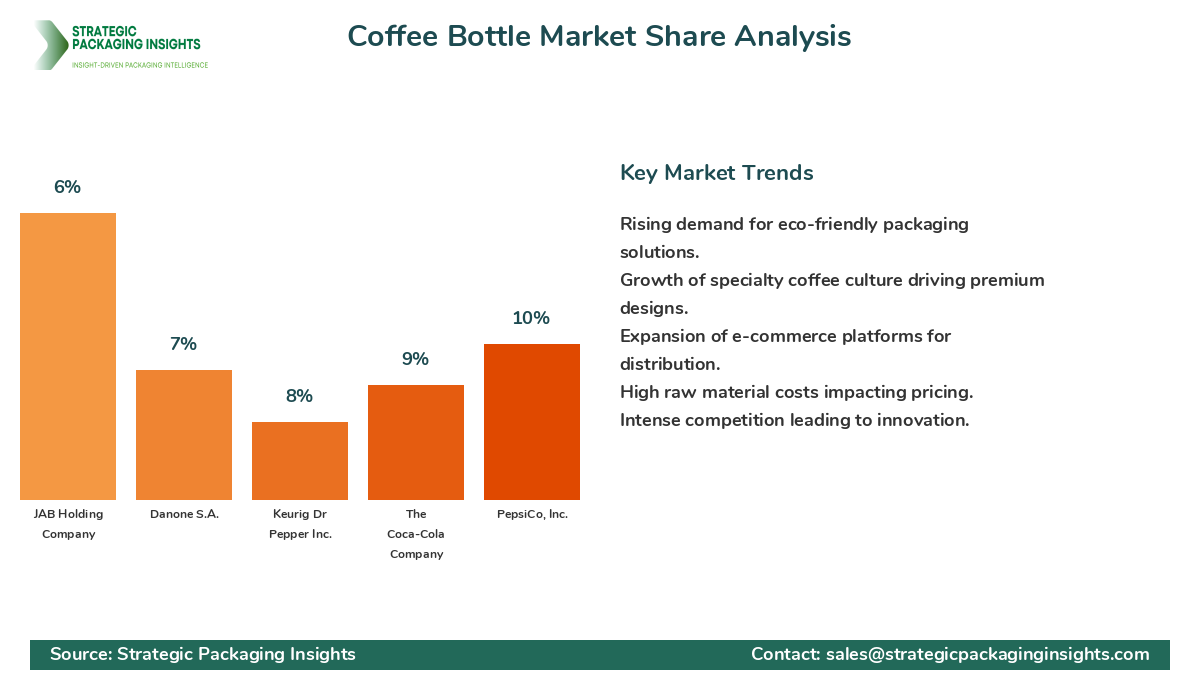- Home
- Beverage Packaging
- Coffee Bottle Market Size, Future Growth and Forecast 2033
Coffee Bottle Market Size, Future Growth and Forecast 2033
Coffee Bottle Market Segments - by Material (Glass, Plastic, Metal), Capacity (Up to 200ml, 200ml-500ml, Above 500ml), Distribution Channel (Online, Offline), End-User (Household, Commercial), and Region (North America, Europe, Asia Pacific, Latin America, and Middle East & Africa) - Market Dynamics, Growth Opportunities, Strategic Drivers, and PESTLE Outlook (2025–2033)
Coffee Bottle Market Outlook
The coffee bottle market was valued at $1.2 billion in 2024 and is projected to reach $2.5 billion by 2033, growing at a CAGR of 8.5% during the forecast period 2025-2033. This growth is driven by the increasing demand for convenient and portable coffee solutions, as consumers continue to seek out on-the-go beverage options. The rise in coffee consumption globally, coupled with the trend towards premium and specialty coffee, is further propelling the market. Additionally, the growing awareness of Sustainable Packaging solutions is encouraging manufacturers to innovate in eco-friendly coffee bottle designs, which is expected to attract environmentally conscious consumers.
Report Scope
| Attributes | Details |
| Report Title | Coffee Bottle Market Size, Future Growth and Forecast 2033 |
| Base Year | 2024 |
| Historic Data | 2017-2023 |
| Forecast Period | 2025-2033 |
| Number of Pages | 209 |
| Material | Glass, Plastic, Metal |
| Capacity | Up to 200ml, 200ml-500ml, Above 500ml |
| Distribution Channel | Online, Offline |
| End-User | Household, Commercial |
| Customization Available | Yes* |
Opportunities & Threats
The coffee bottle market presents numerous opportunities, particularly in the realm of sustainable packaging. As consumers become more environmentally conscious, there is a growing demand for eco-friendly packaging solutions. This trend is pushing manufacturers to develop coffee bottles made from recyclable materials, such as glass and biodegradable plastics. Additionally, the rise of the specialty coffee culture is creating opportunities for premium coffee bottle designs that cater to the aesthetic preferences of consumers. The increasing popularity of cold brew and ready-to-drink coffee beverages is also driving demand for innovative coffee bottle designs that enhance the consumer experience.
Another significant opportunity lies in the expansion of distribution channels. The growth of e-commerce platforms has made it easier for consumers to access a wide variety of coffee bottle options, allowing manufacturers to reach a broader audience. Furthermore, partnerships with coffee shops and cafes can provide manufacturers with direct access to coffee enthusiasts, creating opportunities for co-branding and exclusive product launches. The increasing trend of personalization and customization in consumer products also offers opportunities for manufacturers to offer personalized coffee bottle designs, catering to individual consumer preferences.
However, the coffee bottle market faces several challenges that could hinder its growth. One of the primary restrainers is the high cost of raw materials, particularly for eco-friendly packaging solutions. The production of sustainable materials often involves higher costs, which can impact the pricing of coffee bottles and limit their accessibility to price-sensitive consumers. Additionally, the market is highly competitive, with numerous players vying for market share. This intense competition can lead to price wars and reduced profit margins for manufacturers. Furthermore, regulatory challenges related to packaging materials and environmental standards can pose hurdles for manufacturers looking to innovate in sustainable coffee bottle designs.
The coffee bottle market is characterized by a competitive landscape with several key players holding significant market shares. The market is dominated by a mix of established beverage packaging companies and emerging startups that are innovating in sustainable packaging solutions. The competitive landscape is shaped by factors such as product innovation, brand reputation, distribution networks, and pricing strategies. Companies that can effectively differentiate their products through unique designs, eco-friendly materials, and strong brand positioning are likely to gain a competitive edge in the market.
Leading companies in the coffee bottle market include Nestlé S.A., which holds a substantial market share due to its extensive distribution network and strong brand presence. The company has been focusing on sustainable packaging solutions, which has resonated well with environmentally conscious consumers. Another major player is Starbucks Corporation, known for its innovative coffee bottle designs and collaborations with renowned designers. The company's focus on premium and aesthetically pleasing packaging has helped it capture a significant share of the market.
PepsiCo, Inc. is another key player in the coffee bottle market, leveraging its strong distribution channels and brand recognition to expand its market presence. The company's focus on ready-to-drink coffee beverages has driven demand for its coffee bottle offerings. Similarly, The Coca-Cola Company has been actively expanding its coffee portfolio, with a focus on sustainable packaging solutions. The company's global reach and strong marketing capabilities have contributed to its significant market share.
Other notable players in the market include Keurig Dr Pepper Inc., which has been focusing on innovative coffee bottle designs and partnerships with coffee brands to enhance its product offerings. The company has been investing in research and development to create eco-friendly packaging solutions that align with consumer preferences. Additionally, companies like Danone S.A. and JAB Holding Company have been expanding their coffee bottle portfolios through strategic acquisitions and partnerships, further strengthening their market positions.
Key Highlights Coffee Bottle Market
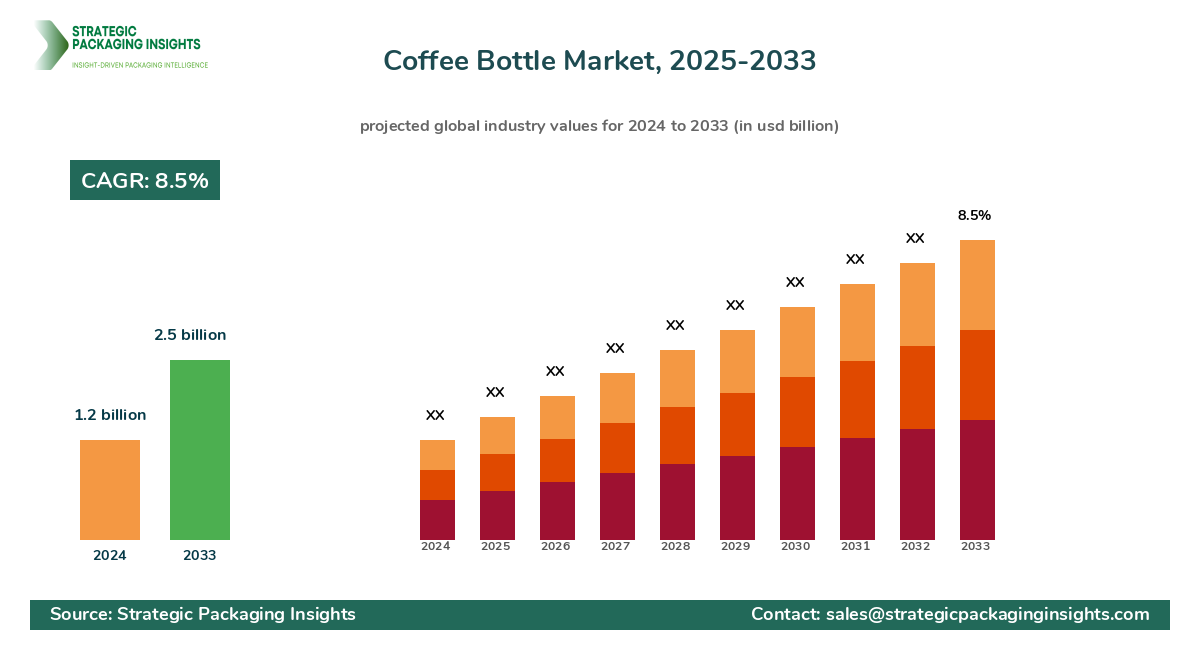
- The coffee bottle market is projected to grow at a CAGR of 8.5% from 2025 to 2033.
- Increasing demand for sustainable and eco-friendly packaging solutions is driving market growth.
- The rise of specialty coffee culture is creating opportunities for premium coffee bottle designs.
- E-commerce platforms are expanding distribution channels for coffee bottles.
- High raw material costs pose a challenge for eco-friendly packaging solutions.
- Leading companies are focusing on product innovation and brand differentiation.
- Partnerships with coffee shops and cafes offer opportunities for co-branding and exclusive launches.
- Regulatory challenges related to packaging materials can impact market growth.
- Personalization and customization trends are influencing coffee bottle designs.
- Intense competition in the market can lead to price wars and reduced profit margins.
Competitive Intelligence
The competitive landscape of the coffee bottle market is shaped by several key players, each vying for market dominance through strategic initiatives and product innovations. Nestlé S.A. is a prominent player, leveraging its extensive distribution network and strong brand presence to capture a significant market share. The company's focus on sustainable packaging solutions has resonated well with environmentally conscious consumers, positioning it as a leader in the market. Nestlé's commitment to innovation and quality has enabled it to maintain a competitive edge, despite the intense competition in the market.
Starbucks Corporation is another major player, known for its innovative coffee bottle designs and collaborations with renowned designers. The company's focus on premium and aesthetically pleasing packaging has helped it capture a significant share of the market. Starbucks' strong brand reputation and loyal customer base have further contributed to its market dominance. The company's strategic partnerships with coffee shops and cafes have provided it with direct access to coffee enthusiasts, enhancing its market reach.
PepsiCo, Inc. is a key player in the coffee bottle market, leveraging its strong distribution channels and brand recognition to expand its market presence. The company's focus on ready-to-drink coffee beverages has driven demand for its coffee bottle offerings. PepsiCo's commitment to sustainability and innovation has enabled it to differentiate its products in the competitive market. Similarly, The Coca-Cola Company has been actively expanding its coffee portfolio, with a focus on sustainable packaging solutions. The company's global reach and strong marketing capabilities have contributed to its significant market share.
Keurig Dr Pepper Inc. has been focusing on innovative coffee bottle designs and partnerships with coffee brands to enhance its product offerings. The company has been investing in research and development to create eco-friendly packaging solutions that align with consumer preferences. Danone S.A. and JAB Holding Company have been expanding their coffee bottle portfolios through strategic acquisitions and partnerships, further strengthening their market positions. These companies are leveraging their global presence and strong distribution networks to capture a larger share of the market.
Regional Market Intelligence of Coffee Bottle
The global coffee bottle market is segmented into several key regions, each exhibiting unique growth patterns and market dynamics. In North America, the market is driven by the high consumption of coffee and the growing demand for convenient and portable coffee solutions. The region's focus on sustainability and eco-friendly packaging is also contributing to market growth. The market in North America was valued at $400 million in 2024 and is expected to grow at a CAGR of 12% during the forecast period.
In Europe, the coffee bottle market is characterized by a strong emphasis on premium and specialty coffee. The region's rich coffee culture and increasing preference for high-quality coffee beverages are driving demand for innovative coffee bottle designs. The market in Europe was valued at $350 million in 2024 and is projected to grow at a CAGR of 9% from 2025 to 2033. The focus on sustainable packaging solutions is also a key driver of market growth in this region.
The Asia Pacific region is experiencing rapid growth in the coffee bottle market, driven by the increasing popularity of coffee among younger consumers and the rise of coffee culture in countries like China and India. The market in Asia Pacific was valued at $450 million in 2024 and is expected to grow at a CAGR of 15% during the forecast period. The region's expanding middle class and increasing disposable incomes are contributing to the demand for premium coffee bottle designs.
In Latin America, the coffee bottle market is driven by the region's rich coffee heritage and the growing trend of ready-to-drink coffee beverages. The market in Latin America was valued at $200 million in 2024 and is projected to grow at a CAGR of 7% from 2025 to 2033. The focus on sustainable and eco-friendly packaging solutions is also contributing to market growth in this region.
The Middle East & Africa region is experiencing moderate growth in the coffee bottle market, driven by the increasing popularity of coffee and the growing demand for convenient beverage solutions. The market in this region was valued at $150 million in 2024 and is expected to grow at a CAGR of 5% during the forecast period. The focus on premium coffee bottle designs and sustainable packaging solutions is also contributing to market growth in this region.
Top Countries Insights in Coffee Bottle
In the United States, the coffee bottle market is driven by the high consumption of coffee and the growing demand for convenient and portable coffee solutions. The market was valued at $300 million in 2024 and is expected to grow at a CAGR of 10% during the forecast period. The focus on sustainable packaging solutions and the rise of specialty coffee culture are key drivers of market growth in the country.
In Germany, the coffee bottle market is characterized by a strong emphasis on premium and specialty coffee. The market was valued at $150 million in 2024 and is projected to grow at a CAGR of 8% from 2025 to 2033. The focus on sustainable packaging solutions and the increasing preference for high-quality coffee beverages are driving demand for innovative coffee bottle designs in the country.
In China, the coffee bottle market is experiencing rapid growth, driven by the increasing popularity of coffee among younger consumers and the rise of coffee culture. The market was valued at $200 million in 2024 and is expected to grow at a CAGR of 12% during the forecast period. The expanding middle class and increasing disposable incomes are contributing to the demand for premium coffee bottle designs in the country.
In Brazil, the coffee bottle market is driven by the region's rich coffee heritage and the growing trend of ready-to-drink coffee beverages. The market was valued at $100 million in 2024 and is projected to grow at a CAGR of 6% from 2025 to 2033. The focus on sustainable and eco-friendly packaging solutions is also contributing to market growth in the country.
In the United Arab Emirates, the coffee bottle market is experiencing moderate growth, driven by the increasing popularity of coffee and the growing demand for convenient beverage solutions. The market was valued at $50 million in 2024 and is expected to grow at a CAGR of 5% during the forecast period. The focus on premium coffee bottle designs and sustainable packaging solutions is also contributing to market growth in the country.
Coffee Bottle Market Segments Insights

Material Analysis
The coffee bottle market is segmented by material into glass, plastic, and metal. Glass bottles are favored for their premium look and feel, appealing to consumers who prioritize aesthetics and sustainability. The demand for glass bottles is driven by the growing trend of eco-friendly packaging, as glass is recyclable and perceived as a healthier option compared to plastic. However, the fragility and higher cost of glass bottles can be a limiting factor for some consumers. Plastic bottles, on the other hand, are popular due to their lightweight and durable nature, making them ideal for on-the-go consumption. The development of biodegradable and recyclable plastics is addressing environmental concerns, further boosting the demand for plastic coffee bottles. Metal bottles, though less common, are gaining traction for their durability and ability to maintain beverage temperature, appealing to consumers who value functionality and longevity.
Capacity Analysis
The coffee bottle market is segmented by capacity into up to 200ml, 200ml-500ml, and above 500ml. Bottles with a capacity of up to 200ml are popular for single-serve and on-the-go consumption, catering to consumers who prefer convenience and portion control. The 200ml-500ml segment is the most popular, offering a balance between portability and sufficient volume for a satisfying coffee experience. This segment is driven by the increasing demand for ready-to-drink coffee beverages and the rise of specialty coffee culture. Bottles with a capacity above 500ml are favored by consumers who prefer larger servings or wish to share their coffee with others. This segment is also gaining popularity among consumers who use coffee bottles for other beverages, such as iced tea or smoothies.
Distribution Channel Analysis
The coffee bottle market is segmented by distribution channel into online and offline. The online segment is experiencing rapid growth, driven by the increasing popularity of e-commerce platforms and the convenience of online shopping. Consumers can easily access a wide variety of coffee bottle options, compare prices, and read reviews, making online shopping an attractive option. The offline segment, which includes supermarkets, hypermarkets, and specialty stores, remains significant due to the tactile experience it offers consumers. In-store promotions and the ability to see and feel the product before purchase are key factors driving the offline segment. Additionally, partnerships with coffee shops and cafes provide manufacturers with direct access to coffee enthusiasts, creating opportunities for co-branding and exclusive product launches.
End-User Analysis
The coffee bottle market is segmented by end-user into household and commercial. The household segment is driven by the increasing demand for convenient and portable coffee solutions for home consumption. Consumers are seeking coffee bottles that offer a balance between aesthetics and functionality, with a growing preference for eco-friendly options. The commercial segment, which includes coffee shops, cafes, and restaurants, is driven by the need for innovative and aesthetically pleasing coffee bottle designs that enhance the consumer experience. The rise of specialty coffee culture and the increasing popularity of ready-to-drink coffee beverages are key drivers of demand in the commercial segment. Partnerships with coffee brands and the development of customized coffee bottle designs are also contributing to the growth of the commercial segment.
Market Share Analysis
The coffee bottle market is characterized by a diverse range of players, each vying for market share through strategic initiatives and product innovations. Leading companies such as Nestlé S.A., Starbucks Corporation, and PepsiCo, Inc. hold significant market shares due to their strong brand presence and extensive distribution networks. These companies are focusing on sustainable packaging solutions and innovative coffee bottle designs to differentiate their products and capture a larger share of the market. Emerging players and startups are also gaining traction by offering unique and eco-friendly coffee bottle designs that cater to the growing demand for sustainable packaging solutions. The competitive landscape is shaped by factors such as product innovation, brand reputation, distribution networks, and pricing strategies. Companies that can effectively differentiate their products through unique designs, eco-friendly materials, and strong brand positioning are likely to gain a competitive edge in the market.
Coffee Bottle Market Segments
The Coffee Bottle market has been segmented on the basis of
Material
- Glass
- Plastic
- Metal
Capacity
- Up to 200ml
- 200ml-500ml
- Above 500ml
Distribution Channel
- Online
- Offline
End-User
- Household
- Commercial
Primary Interview Insights
What are the key drivers of growth in the coffee bottle market?
What challenges does the coffee bottle market face?
How are companies differentiating their products in the coffee bottle market?
What role do distribution channels play in the coffee bottle market?
How is the trend of personalization influencing the coffee bottle market?
Latest Reports

The Hot Melt Glue Labeler market was valued at $1.2 billion in 2024 and is projected to reach $2.3 billion by 2033, growing at a CAGR of 6.5% during the forecast period 2025–2033.

The Ethical Label market was valued at $1.5 billion in 2024 and is projected to reach $3.2 billion by 2033, growing at a CAGR of 8.5% during the forecast period 2025–2033.

The Packaging Tensioner market was valued at $1.2 billion in 2024 and is projected to reach $2.3 billion by 2033, growing at a CAGR of 6.5% during the forecast period 2025–2033.
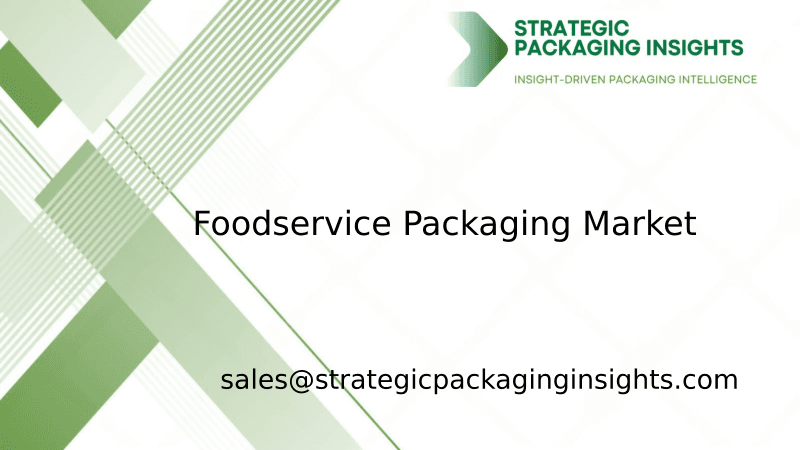
The foodservice packaging market was valued at $120 billion in 2024 and is projected to reach $180 billion by 2033, growing at a CAGR of 4.5% during the forecast period 2025–2033.

The nano-enabled packaging market was valued at $15.2 billion in 2024 and is projected to reach $35.6 billion by 2033, growing at a CAGR of 9.5% during the forecast period 2025–2033.
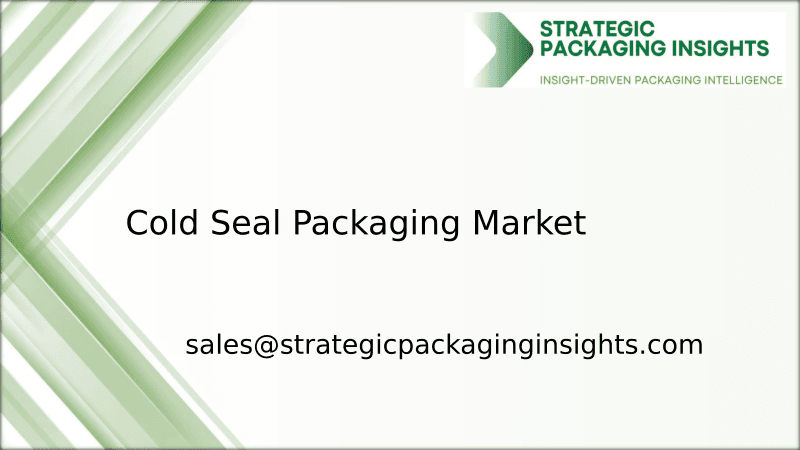
The Cold Seal Packaging market was valued at $1.5 billion in 2024 and is projected to reach $2.3 billion by 2033, growing at a CAGR of 4.8% during the forecast period 2025–2033.

The Transparent Barrier Packaging Films market was valued at $12.5 billion in 2024 and is projected to reach $20.3 billion by 2033, growing at a CAGR of 5.8% during the forecast period 2025–2033.
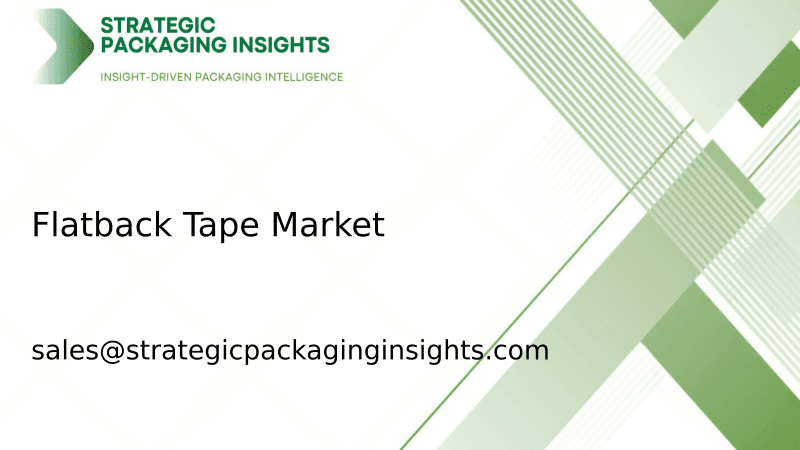
The Flatback Tape market was valued at $2.5 billion in 2024 and is projected to reach $4.1 billion by 2033, growing at a CAGR of 5.8% during the forecast period 2025–2033.
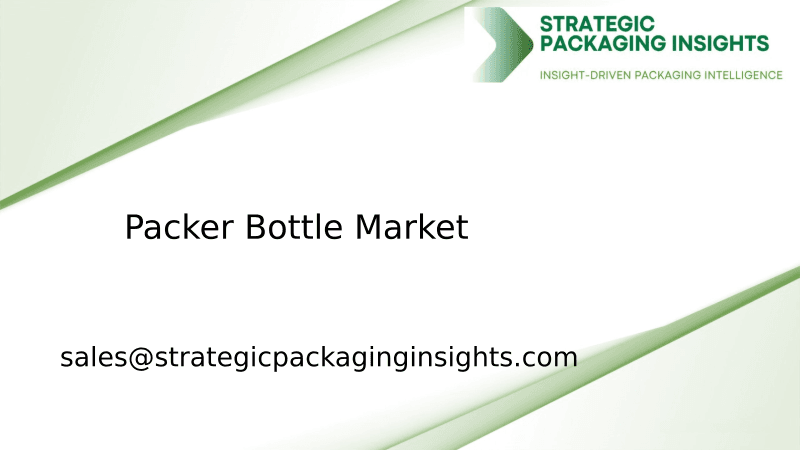
The packer bottle market was valued at $3.5 billion in 2024 and is projected to reach $5.8 billion by 2033, growing at a CAGR of 5.2% during the forecast period 2025–2033.
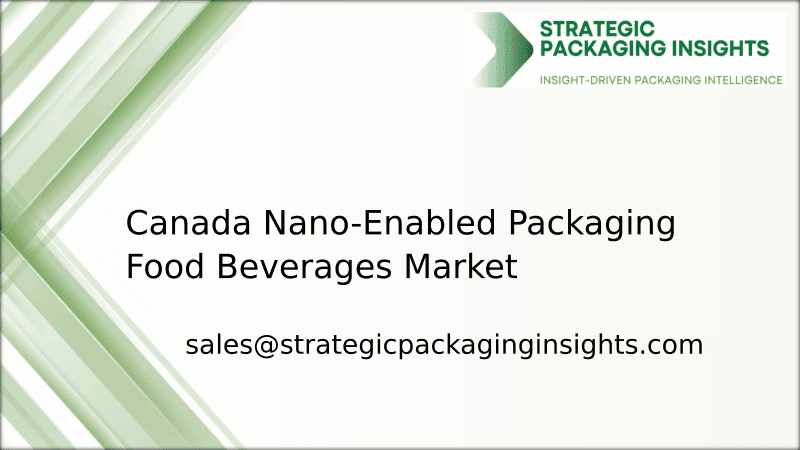
The Canada Nano-Enabled Packaging Food Beverages market was valued at $1.2 billion in 2024 and is projected to reach $3.5 billion by 2033, growing at a CAGR of 12.5% during the forecast period 2025–2033.
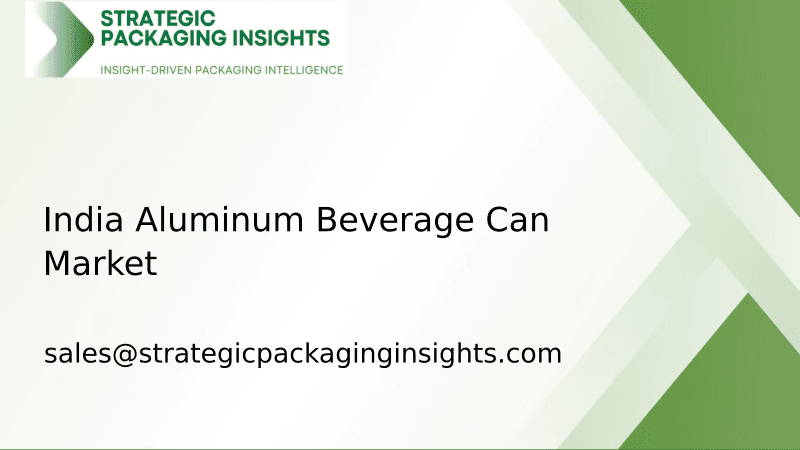
The India Aluminum Beverage Can market was valued at $1.2 billion in 2024 and is projected to reach $2.5 billion by 2033, growing at a CAGR of 8.5% during the forecast period 2025–2033.
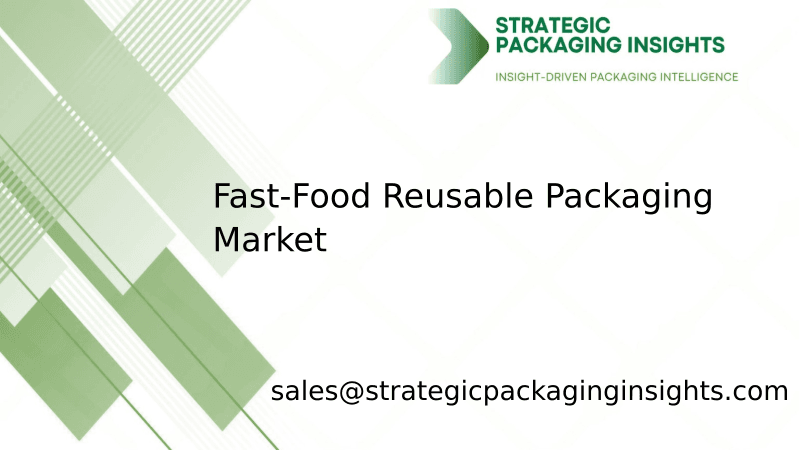
The fast-food reusable packaging market was valued at $1.2 billion in 2024 and is projected to reach $3.5 billion by 2033, growing at a CAGR of 12.5% during the forecast period 2025–2033.
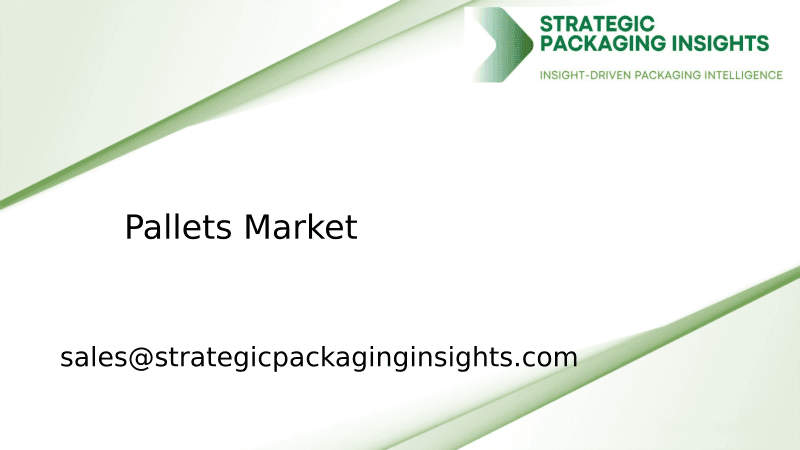
The pallets market was valued at $59.91 billion in 2024 and is projected to reach $88.69 billion by 2033, growing at a CAGR of 4.5% during the forecast period 2025–2033.

The lamination adhesives market was valued at $2.5 billion in 2024 and is projected to reach $4.1 billion by 2033, growing at a CAGR of 5.8% during the forecast period 2025–2033.

The garment packing machine market was valued at $1.2 billion in 2024 and is projected to reach $2.5 billion by 2033, growing at a CAGR of 8.5% during the forecast period 2025–2033.
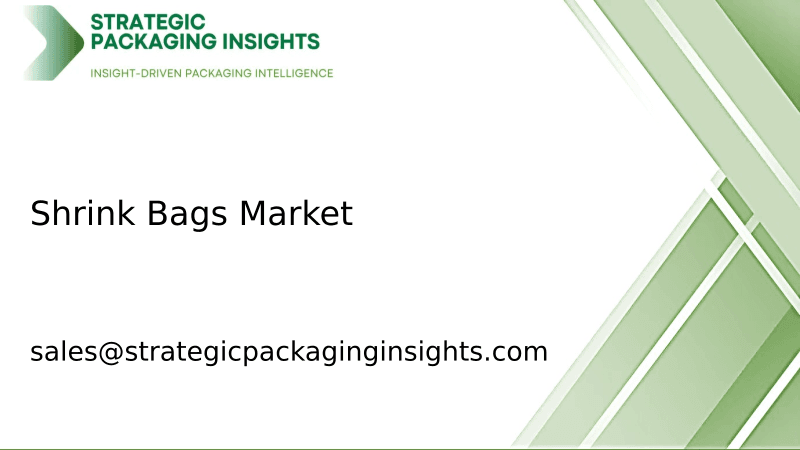
The shrink bags market was valued at $3.5 billion in 2024 and is projected to reach $5.8 billion by 2033, growing at a CAGR of 5.2% during the forecast period 2025–2033.
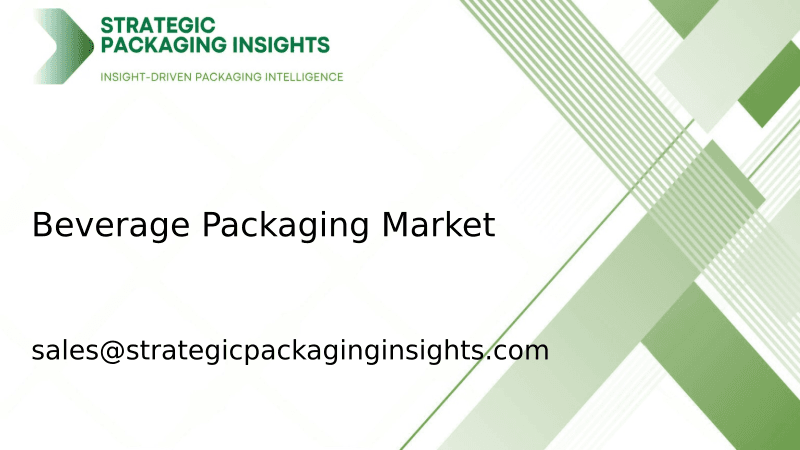
The beverage packaging market was valued at $128 billion in 2024 and is projected to reach $186 billion by 2033, growing at a CAGR of 4.2% during the forecast period 2025–2033.
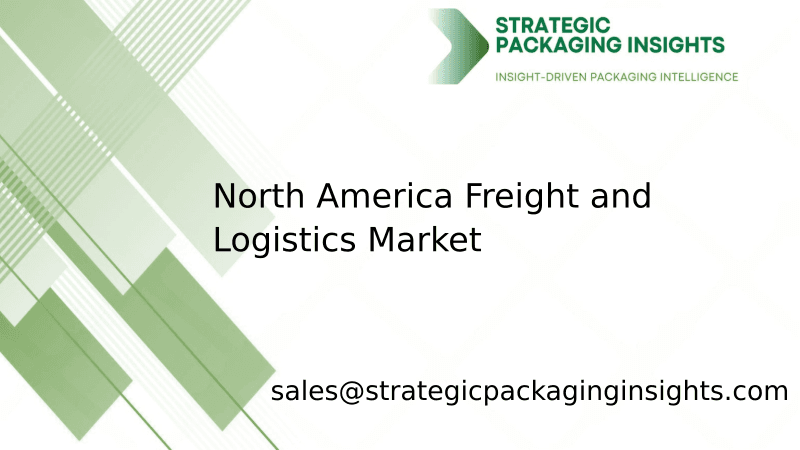
The North America Freight and Logistics market was valued at $1,200 billion in 2024 and is projected to reach $1,800 billion by 2033, growing at a CAGR of 4.5% during the forecast period 2025–2033.

The Anti-Counterfeiting Packaging market was valued at $105 billion in 2024 and is projected to reach $182 billion by 2033, growing at a CAGR of 6.5% during the forecast period 2025–2033.

The Active and Modified Atmospheric Packaging market was valued at $15.2 billion in 2024 and is projected to reach $25.8 billion by 2033, growing at a CAGR of 6.5% during the forecast period 2025–2033.

The molded fiber packaging market was valued at $7.5 billion in 2024 and is projected to reach $12.3 billion by 2033, growing at a CAGR of 5.8% during the forecast period 2025–2033.

The micro packaging market was valued at $1.2 billion in 2024 and is projected to reach $2.5 billion by 2033, growing at a CAGR of 8.5% during the forecast period 2025–2033.

The Anti-counterfeit Pharmaceuticals Packaging market was valued at $80 billion in 2024 and is projected to reach $150 billion by 2033, growing at a CAGR of 7.5% during the forecast period 2025–2033.
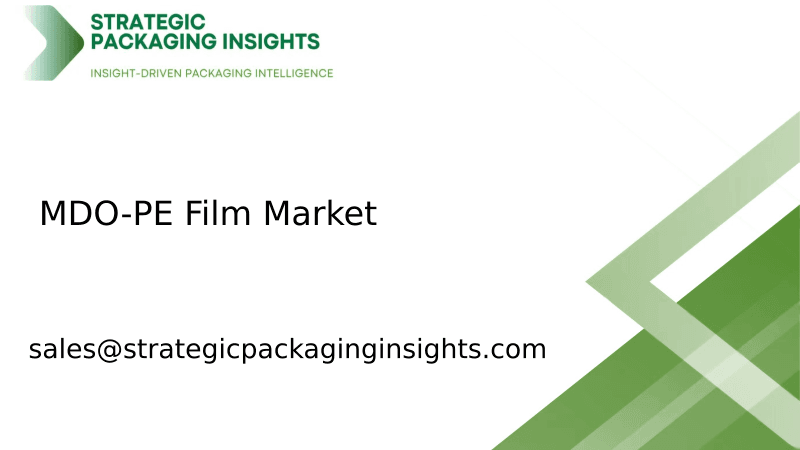
The MDO-PE Film market was valued at $3.5 billion in 2024 and is projected to reach $5.8 billion by 2033, growing at a CAGR of 5.2% during the forecast period 2025–2033.
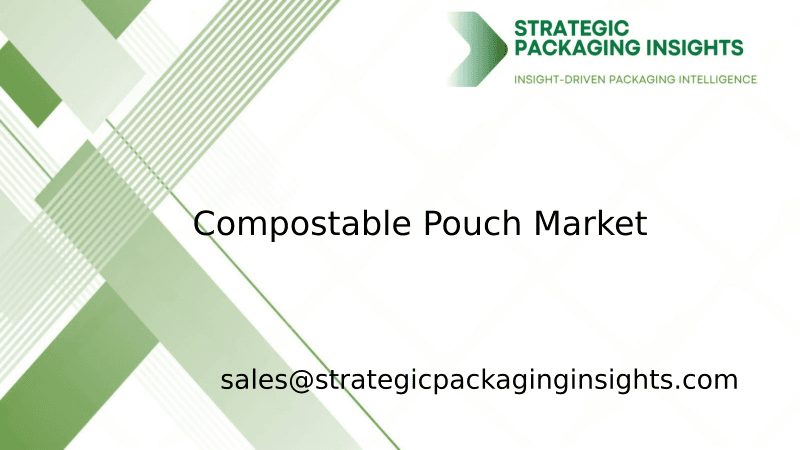
The compostable pouch market was valued at $1.2 billion in 2024 and is projected to reach $3.5 billion by 2033, growing at a CAGR of 12.5% during the forecast period 2025–2033.

The Hot Melt Glue Labeler market was valued at $1.2 billion in 2024 and is projected to reach $2.3 billion by 2033, growing at a CAGR of 6.5% during the forecast period 2025–2033.

The Ethical Label market was valued at $1.5 billion in 2024 and is projected to reach $3.2 billion by 2033, growing at a CAGR of 8.5% during the forecast period 2025–2033.

The Packaging Tensioner market was valued at $1.2 billion in 2024 and is projected to reach $2.3 billion by 2033, growing at a CAGR of 6.5% during the forecast period 2025–2033.

The foodservice packaging market was valued at $120 billion in 2024 and is projected to reach $180 billion by 2033, growing at a CAGR of 4.5% during the forecast period 2025–2033.

The nano-enabled packaging market was valued at $15.2 billion in 2024 and is projected to reach $35.6 billion by 2033, growing at a CAGR of 9.5% during the forecast period 2025–2033.

The Cold Seal Packaging market was valued at $1.5 billion in 2024 and is projected to reach $2.3 billion by 2033, growing at a CAGR of 4.8% during the forecast period 2025–2033.

The Transparent Barrier Packaging Films market was valued at $12.5 billion in 2024 and is projected to reach $20.3 billion by 2033, growing at a CAGR of 5.8% during the forecast period 2025–2033.

The Flatback Tape market was valued at $2.5 billion in 2024 and is projected to reach $4.1 billion by 2033, growing at a CAGR of 5.8% during the forecast period 2025–2033.

The packer bottle market was valued at $3.5 billion in 2024 and is projected to reach $5.8 billion by 2033, growing at a CAGR of 5.2% during the forecast period 2025–2033.

The Canada Nano-Enabled Packaging Food Beverages market was valued at $1.2 billion in 2024 and is projected to reach $3.5 billion by 2033, growing at a CAGR of 12.5% during the forecast period 2025–2033.

The India Aluminum Beverage Can market was valued at $1.2 billion in 2024 and is projected to reach $2.5 billion by 2033, growing at a CAGR of 8.5% during the forecast period 2025–2033.

The fast-food reusable packaging market was valued at $1.2 billion in 2024 and is projected to reach $3.5 billion by 2033, growing at a CAGR of 12.5% during the forecast period 2025–2033.

The pallets market was valued at $59.91 billion in 2024 and is projected to reach $88.69 billion by 2033, growing at a CAGR of 4.5% during the forecast period 2025–2033.

The lamination adhesives market was valued at $2.5 billion in 2024 and is projected to reach $4.1 billion by 2033, growing at a CAGR of 5.8% during the forecast period 2025–2033.

The garment packing machine market was valued at $1.2 billion in 2024 and is projected to reach $2.5 billion by 2033, growing at a CAGR of 8.5% during the forecast period 2025–2033.

The shrink bags market was valued at $3.5 billion in 2024 and is projected to reach $5.8 billion by 2033, growing at a CAGR of 5.2% during the forecast period 2025–2033.

The beverage packaging market was valued at $128 billion in 2024 and is projected to reach $186 billion by 2033, growing at a CAGR of 4.2% during the forecast period 2025–2033.

The North America Freight and Logistics market was valued at $1,200 billion in 2024 and is projected to reach $1,800 billion by 2033, growing at a CAGR of 4.5% during the forecast period 2025–2033.

The Anti-Counterfeiting Packaging market was valued at $105 billion in 2024 and is projected to reach $182 billion by 2033, growing at a CAGR of 6.5% during the forecast period 2025–2033.

The Active and Modified Atmospheric Packaging market was valued at $15.2 billion in 2024 and is projected to reach $25.8 billion by 2033, growing at a CAGR of 6.5% during the forecast period 2025–2033.

The molded fiber packaging market was valued at $7.5 billion in 2024 and is projected to reach $12.3 billion by 2033, growing at a CAGR of 5.8% during the forecast period 2025–2033.

The micro packaging market was valued at $1.2 billion in 2024 and is projected to reach $2.5 billion by 2033, growing at a CAGR of 8.5% during the forecast period 2025–2033.

The Anti-counterfeit Pharmaceuticals Packaging market was valued at $80 billion in 2024 and is projected to reach $150 billion by 2033, growing at a CAGR of 7.5% during the forecast period 2025–2033.

The MDO-PE Film market was valued at $3.5 billion in 2024 and is projected to reach $5.8 billion by 2033, growing at a CAGR of 5.2% during the forecast period 2025–2033.

The compostable pouch market was valued at $1.2 billion in 2024 and is projected to reach $3.5 billion by 2033, growing at a CAGR of 12.5% during the forecast period 2025–2033.
